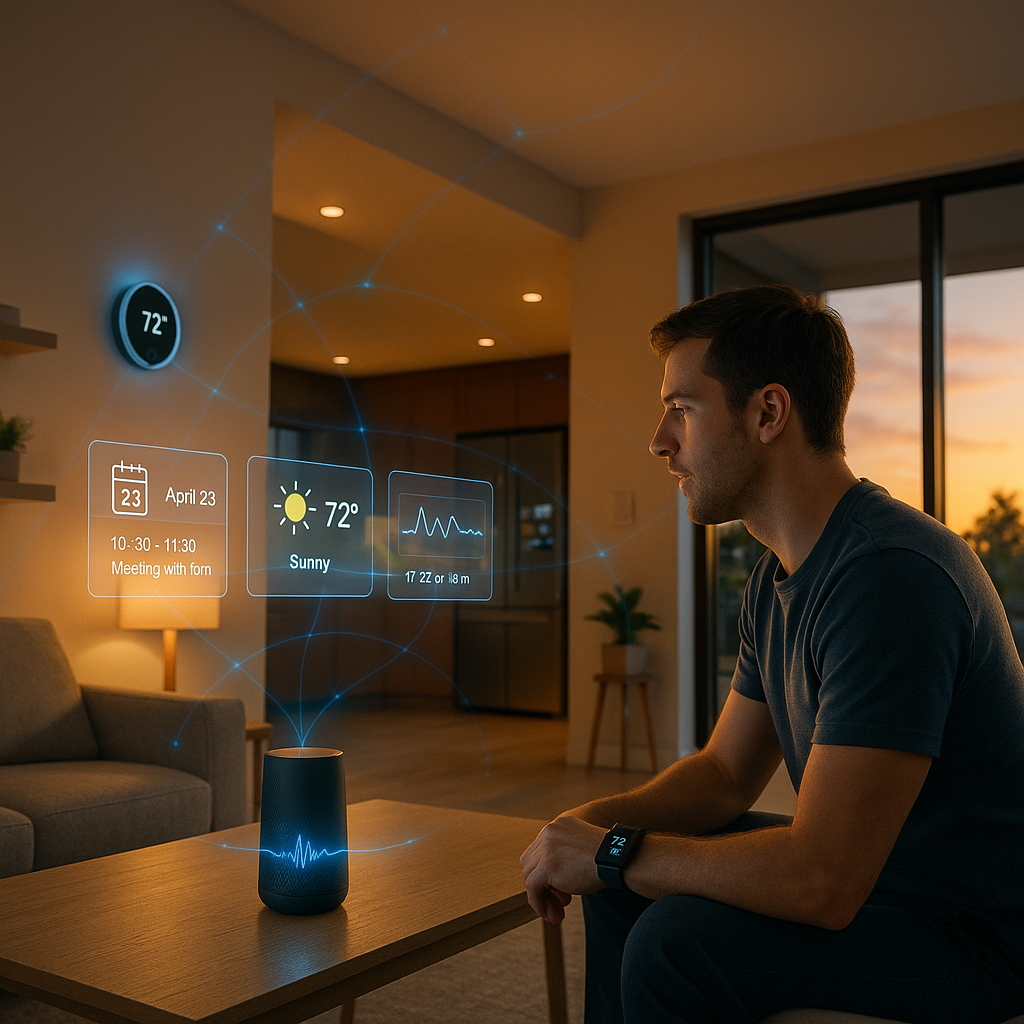Key Takeaways
- AI assistants are rapidly reshaping how we interact with our homes, devices, and daily routines. The future promises smart living that is more intuitive, adaptive, and accessible than ever before. Here are the top predictions and insights into how AI assistants will transform everyday life across a variety of domains.
- Hyper-personalized convenience is set to become standard. AI assistants will not only automate recurring tasks, but also intuitively anticipate individual preferences, deliver tailored recommendations, and orchestrate daily routines with minimal friction.
- Voice-driven control is evolving well beyond basic commands. Enhanced natural language processing will enable hands-free management of smart appliances, calendars, health reminders, workplace tools, and more (across home, office, and mobile environments).
- Seamless ecosystem integration is fueling a new era of smart living. AI assistants will bridge diverse devices, applications, and platforms, creating unified and context-aware experiences that minimize fragmentation and boost productivity.
- Proactive problem-solving is redefining home, office, and facility management. Future AI assistants will detect and address potential issues (like energy inefficiencies, device malfunctions, or maintenance needs) before they escalate. Solutions may be suggested or even automated, all without requiring user intervention.
- Privacy and trust are becoming top priorities. As AI systems manage more sensitive information, transparent privacy controls and robust data security will be indispensable. Ensuring user confidence in digital co-pilots is now an industry imperative.
- Accessibility and inclusivity are accelerating adoption. AI-powered tools are becoming more attuned to the needs of people with disabilities, varying tech skills, and diverse cultural backgrounds, ensuring the benefits of smart living reach everyone.
- Lifelong learning will continue to enhance adaptability. AI assistants will progressively refine their capabilities through user feedback and changes in lifestyle, ensuring experiences remain relevant, helpful, and engaging.
From hyper-personalized convenience to smarter problem-solving and increased accessibility, these trends highlight how AI assistants are evolving from niche tools to indispensable partners, both at home and beyond. As we explore these predictions, discover what the future of AI-powered living means for your daily routines and digital well-being.
Introduction
Imagine waking up to a home that gently adjusts the lighting, brews your preferred coffee, and offers an agenda tailored to your energy levels and priorities. All without you lifting a finger. What was once the stuff of science fiction is fast becoming reality, thanks to advanced AI assistants orchestrating every facet of our digital experiences. No longer confined to simple voice commands or basic reminders, today’s AI assistants are elevating smart living into a new era of seamless integration, proactive support, and truly human-centric design.
This transformation extends beyond the walls of our homes, shaping how we work, interact with technology, maintain our well-being, and safeguard our personal information. As we unpack the top predictions for AI’s role in everyday life, let’s uncover how these systems will unlock more convenience, adaptability, and trust, empowering users across the spectrum of tech familiarity and need.
The Evolution of AI Assistants in Home Environments
To appreciate where AI assistants are heading, it’s essential to understand their journey so far. What started as simple voice-activated tools has matured into sophisticated ambient computing environments capable of understanding and anticipating complex user needs. Leading technology companies (including Amazon, Google, Apple, and Samsung) have driven this shift from standalone speakers to deeply interconnected ecosystems.
Un passo avanti. Sempre.
Unisciti al nostro canale Telegram per ricevere
aggiornamenti mirati, notizie selezionate e contenuti che fanno davvero la differenza.
Zero distrazioni, solo ciò che conta.
 Entra nel Canale
Entra nel Canale
Notable innovations include multimodal interactions, enabling users to engage through a combination of voice, touch, gesture, and visual cues. For example, modern systems can interpret a spoken request alongside a pointing gesture to respond with greater contextual relevance. These developments signal a clear movement toward more natural and seamless human-AI collaboration.
Building on this, cutting-edge assistants now harness behavioral learning and contextual awareness. Rather than passively following commands, they dynamically adapt to the user’s evolving lifestyle.
From Reactive to Proactive Assistance
This deeper integration marks a critical shift:
- Contextual awareness: AI systems automatically adjust lighting, temperature, or device settings based on time of day, weather, occupancy, or current activity within the environment.
- Behavioral learning: Assistants recognize patterns (like morning routines or evening entertainment habits), anticipating needs before they’re articulated.
- Predictive maintenance: Home systems can forecast when appliances might require service, schedule maintenance automatically, or alert homeowners to potential issues.
This evolution empowers more valuable, tailored experiences and lays the groundwork for fully autonomous management across homes, workplaces, and beyond.
Predicted Impact on Daily Routines
The growing sophistication of AI assistants is revolutionizing how we manage our daily tasks, transforming routine interactions into seamless, intelligent support systems. Their influence is tangible from the moment you wake through every facet of work, leisure, and personal care.
Morning Routines and Productivity
AI assistants are at the forefront of optimizing morning routines and boosting productivity. Key examples include:
- Smart wake-up sequences: Wake-up times are aligned with your natural sleep cycles and anticipated agenda, using ambient lighting and sound cues for a smoother start.
- Automated preparation: From prepping your favorite morning drink to preheating your workstation or reviewing personalized news briefs, AI-driven routines reduce cognitive and manual load.
- Commute and schedule optimization: Real-time traffic analysis and integration with calendar apps enable proactive route planning and schedule adjustments.
- Task prioritization: AI systems can summarize the day’s main objectives, highlight urgent communications, and surface key meetings or deadlines.
As these tools learn more about each user, their recommendations become increasingly intuitive. They adapt to shifts in habits, work demands, or lifestyle changes.
In the workplace, similar AI functionalities are automating task assignments, project updates, and meeting summaries, improving efficiency for remote teams and busy professionals.
Health and Wellness Integration
AI assistants are also ushering in a new era of home-based wellness and proactive healthcare:
- Continuous health monitoring: Integration with wearables and smart sensors enables real-time tracking of vital signs, physical activity, and sleep quality.
- Personalized nutritional guidance: By analyzing biometric data and dietary preferences, AI can suggest balanced meals, hydration reminders, or grocery lists tailored to health goals.
- Environmental optimization: Automated adjustment of lighting, temperature, and air quality fosters environments conducive to relaxation, sleep, or focused work.
- Early health alerts: AI-powered systems identify anomalies (such as irregular heart rates or temperature fluctuations) and notify users or caregivers of emerging health concerns.
Beyond home use, similar technology is being deployed in assisted living, hospitals, and educational settings to enhance patient outcomes and streamline care delivery.
Smart Living Ecosystems
The future of AI-powered living hinges on the emergence of unified ecosystems that seamlessly connect devices, applications, and services across locations and lifestyles.
Cross-Platform Integration
Interoperability among different brands, platforms, and protocols is now a primary focus area. AI assistants are bridging gaps between devices from various manufacturers, syncing diverse accounts, and facilitating smoother transitions between home, office, and mobile environments.
- Manufacturer collaboration: Partnerships among leading tech brands are helping establish common standards for device compatibility and user experience consistency.
- Multi-platform management: Assistants can now control security systems, entertainment centers, appliances, and even fitness equipment from a single hub, providing a unified interface for users.
- Hybrid work facilitation: From remote work tools to digital classroom management, AI is syncing schedules, automating collaboration, and simplifying cross-device workflows for a mobile, modern workforce.
This interconnectedness is vital for reducing fragmentation and ensuring that convenience is not lost amid technological diversity.
Adaptive Learning Systems
The intelligence of AI assistants is increasingly rooted in their capacity to learn and adjust dynamically.
- Pattern recognition: Assisting users with unique household routines, priorities, or preferences by observing and adapting in real time.
- Contextual adaptation: Enhanced awareness of time, location, and user states enables assistants to recommend actions most relevant to each unique context.
- Multi-user customization: AI is recognizing and adjusting for the preferences of different household members, streamlining everything from lighting scenes to entertainment choices.
- Environmental responsiveness: Real-time adaptation to weather, air quality changes, or external events ensures home comfort and safety is always optimized.
Other industries, such as retail (personalized shopping experiences), finance (custom investment alerts), and legal (automated contract review), are also adopting adaptive AI to provide user-specific solutions on demand.
Privacy and Security Considerations
As AI assistants become ever more embedded in daily routines and handle growing volumes of personal and sensitive information, the demand for privacy and security is surging. A strong foundation of user trust is crucial for mass adoption.
Un passo avanti. Sempre.
Unisciti al nostro canale Telegram per ricevere
aggiornamenti mirati, notizie selezionate e contenuti che fanno davvero la differenza.
Zero distrazioni, solo ciò che conta.
 Entra nel Canale
Entra nel Canale
- End-to-end encryption: Data transmitted between devices, cloud, and user interfaces is increasingly protected by robust encryption standards, securing communications against interception.
- Localized data processing: Many AI assistants now support on-device computation to limit data leaving the user’s environment, reducing exposure to external threats.
- Granular privacy controls: Users can fine-tune access permissions, designate trusted contacts, and manage what information is retained or forgotten by their assistants.
- Biometric authentication: Advanced verification technologies (such as fingerprint or facial recognition) are being used for sensitive tasks or payment approvals, elevating both convenience and data protection.
The industry’s evolving approach emphasizes “privacy by design,” ensuring security is not an afterthought but an integral part of every feature and product release.
Beyond the home, these principles are vital for enterprise settings, healthcare facilities, and educational institutions, safeguarding both proprietary and personal data while delivering essential services.
Conclusion
AI assistants are no longer simply responsive tools. They have become proactive, personalized partners in our everyday lives. From enhancing morning routines to optimizing home environments and managing wellness, their impact is expanding across home, workplace, education, and even healthcare settings. The emergence of seamless, adaptive smart living ecosystems signals a new standard for convenience and efficiency that caters to the individual while supporting whole households and teams.
As these systems become more interconnected and capable, ensuring robust privacy and security is not just a feature but a foundational requirement. Transparent controls and trustworthy AI design are now central to gaining and maintaining user confidence.
Looking forward, the true differentiator for individuals, families, and businesses will be not just the adoption of AI assistants, but the ability to harness their adaptability, inclusivity, and intelligent anticipation. Smart living is on the cusp of evolving from convenience to true empowerment. The question is, how will you leverage these advancements to enrich your daily life, achieve new levels of productivity, and safeguard your digital well-being in a landscape where technology is finally working for you (not the other way around)?




Leave a Reply